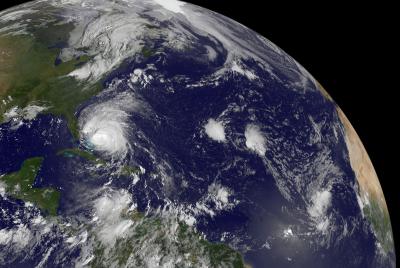Hurricane Evacuations: Why Some Won't Go

Tourists and residents are fleeing the coastal islands of North Carolina as Hurricane Irene approaches the East Coast of the United States today (Aug. 25). But if history is any guide, some people in the path of the hurricane will refuse to leave their homes and businesses. Why would anyone put themselves on a collision course with a Category 3 storm?
Everyone has their own pros and cons to weigh when making their evacuate-or-not-to-evacuate decisions, said Josh Klapow, a psychologist at the University of Alabama, Birmingham, who specializes in disaster preparedness. One major factor, Klapow told Livescience, is how tough evacuation is likely to be.
"They don't go because, frankly, they don't believe that the impact of the event is going to be dangerous enough to warrant leaving the house," Klapow said.
Irene evacuations
In Dare County, N.C., which contains a long line of vulnerable barrier islands, about 150,000 visitors were ordered to evacuate today. A mandatory evacuation for all residents goes into effect at 8 a.m. local time tomorrow (Aug. 26). In New York, Mayor Michael Bloomberg told reporters that officials were preparing to order evacuations from low-lying areas of the city if conditions become dangerous.
Evacuating large urban areas can be difficult. In 2005, traffic out of Houston came to a standstill and drivers ran out of gas after officials urged residents to flee the path of Hurricane Rita. About 100 people are estimated to have died in the Rita evacuation in Texas from traffic accidents, heatstroke and other causes.
Bad evacuation experiences can make some people believe that weathering a storm is preferable to the trauma of heading out of town, Klapow said. In 2008, during Hurricane Ike's fury, as many as 140,000 residents ignored evacuation warnings in Texas, choosing to shelter in place. One contributing factor may have been the botched Rita evacuation. (Ike caused deaths and extensive damage across parts of the Caribbean and the coasts of Texas and Louisiana.)
Sign up for the Live Science daily newsletter now
Get the world’s most fascinating discoveries delivered straight to your inbox.
"If your house didn't get destroyed, all of the information that's feeding into your experience is, 'Evacuation is horrific, my house didn't get destroyed, so why would I go?'" Klapow said.
Some people stay because they're very attached to their homes and possessions, Klapow said. Others who've survived earlier storms may conclude that they can handle anything that comes their way. That's not necessarily true, Klapow said.
"If you rode out three storms, then all you know is that you rode out three storms," he said.
How to prepare
Financial concerns, such as being unable to afford a motel or transportation, can keep some people from evacuating. If resources are an issue, residents should call their local emergency management services to find out where to go and how to get there, Klapow said. The Humane Society recommends making evacuation plans for pets, as well.
Anyone in an area where evacuation could become necessary should plan where they're going and how they'll get there, Klapow said. He also urged residents in potential storm-impact areas to gather together medications, basic first aid supplies, food and water.
"If you've got some water, a little bit of food, a basic first aid kit and your meds, then if you need to get out for a couple days, you're going to be okay," he said.
You can follow LiveScience senior writer Stephanie Pappas on Twitter @sipappas. Follow LiveScience for the latest in science news and discoveries on Twitter @livescience and on Facebook.

Stephanie Pappas is a contributing writer for Live Science, covering topics ranging from geoscience to archaeology to the human brain and behavior. She was previously a senior writer for Live Science but is now a freelancer based in Denver, Colorado, and regularly contributes to Scientific American and The Monitor, the monthly magazine of the American Psychological Association. Stephanie received a bachelor's degree in psychology from the University of South Carolina and a graduate certificate in science communication from the University of California, Santa Cruz.










